Why you can trust Tom's Hardware
We have both 1080p medium and 1080p ultra testing results for the RTX 4070 Super and other GPUs, though most people buying a $600 graphics card probably aren't planning to run medium settings and perhaps not even 1080p.
Keep in mind that 1080p is also the render resolution for Performance mode 4K upscaling, or relatively close to the render resolution for Quality mode 1440p upscaling. Not all games support upscaling, but it's an increasingly common feature and we still have hopes that some day we'll get universal upscaling support — like via Nvidia Streamline, which Intel has committed to supporting. One API that in theory provides DLSS, FSR, and XeSS support. So far, however, no games seem to actually be using Streamline.
But enough stalling, let's get to the 1080p benchmarks...
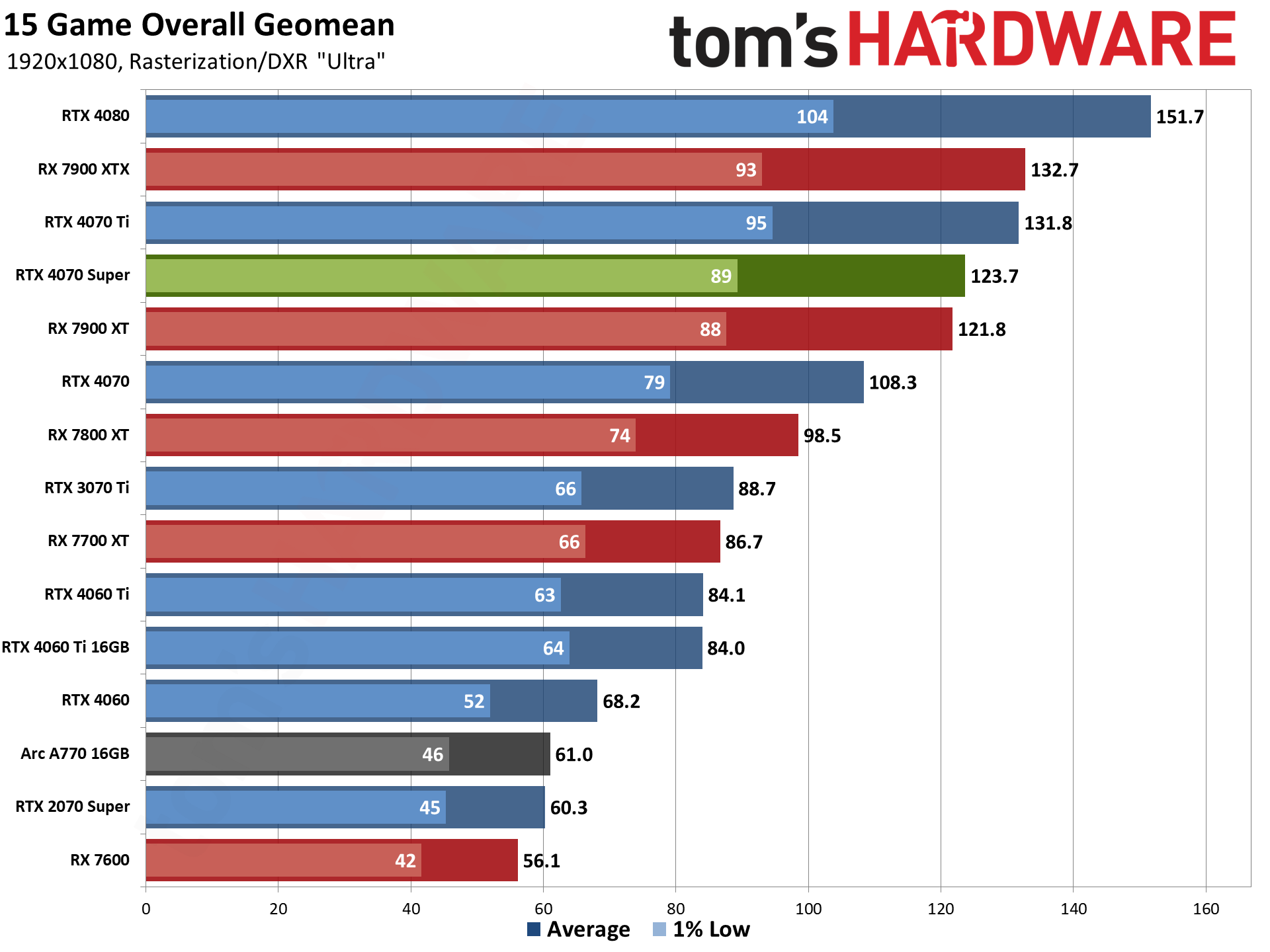
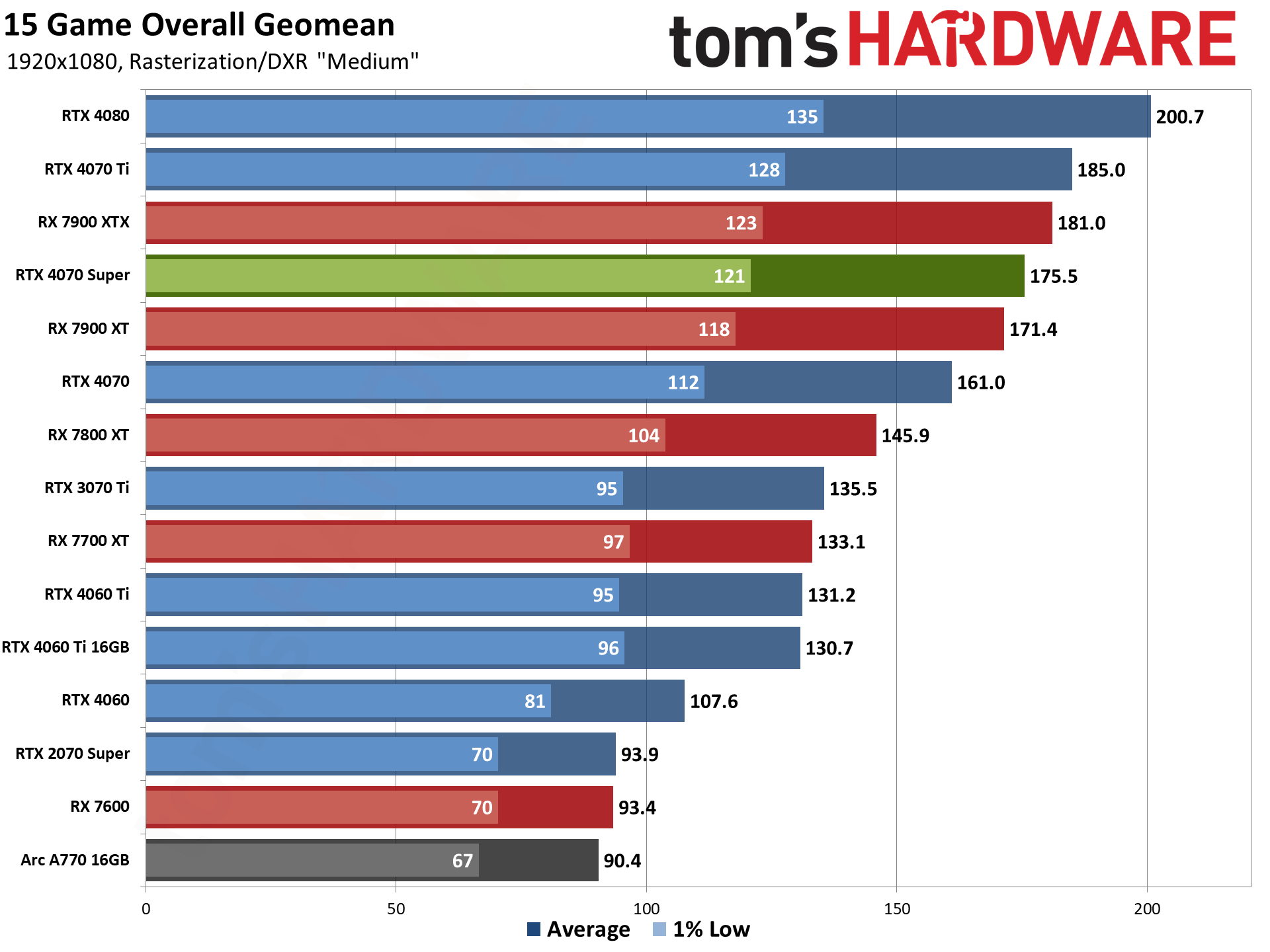
Again, there's nothing too surprising here. The 4070 Super lands between the 4070 and 4070 Ti, 14% faster than the former and 6% slower than the latter at 1080p ultra — and those margins shrink to 9% faster and 5% slower at 1080p medium, where other bottlenecks become more of a limiting factor.
Of course performance isn't a problem at 1080p, with nearly every game running at over 100 fps. Only Bright Memory Infinite, Cyberpunk 2077, and Metro Exodus fail to break 100 fps at 1080p ultra, though they're both still running above 60 fps.
Against AMD's GPUs, the 4070 Super comes in a few percent faster than the 7900 XT overall, and several percent slower than the 7900 XTX. That's also expected, as 1080p will be less demanding of the memory, compute, and L2 cache.


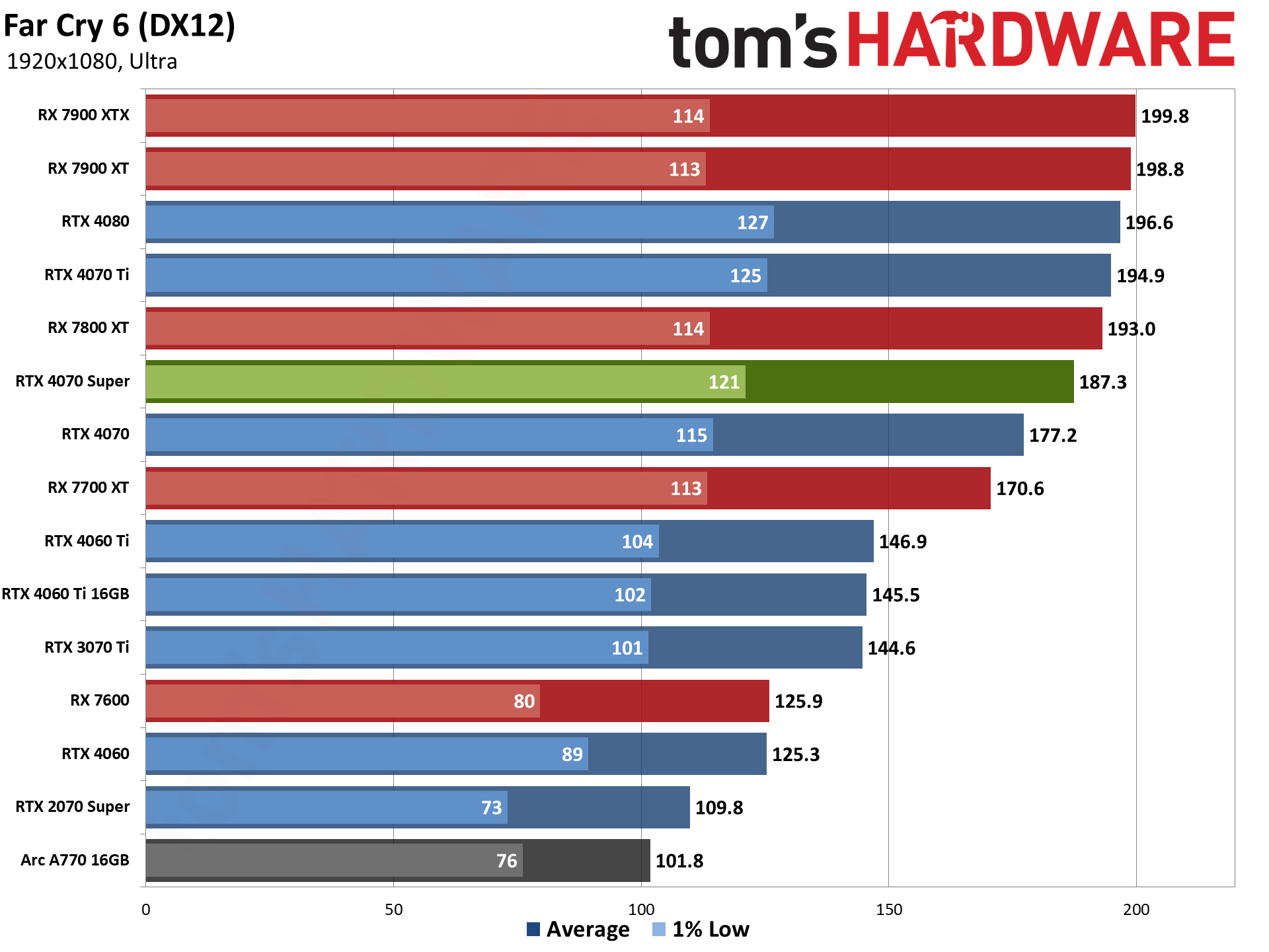
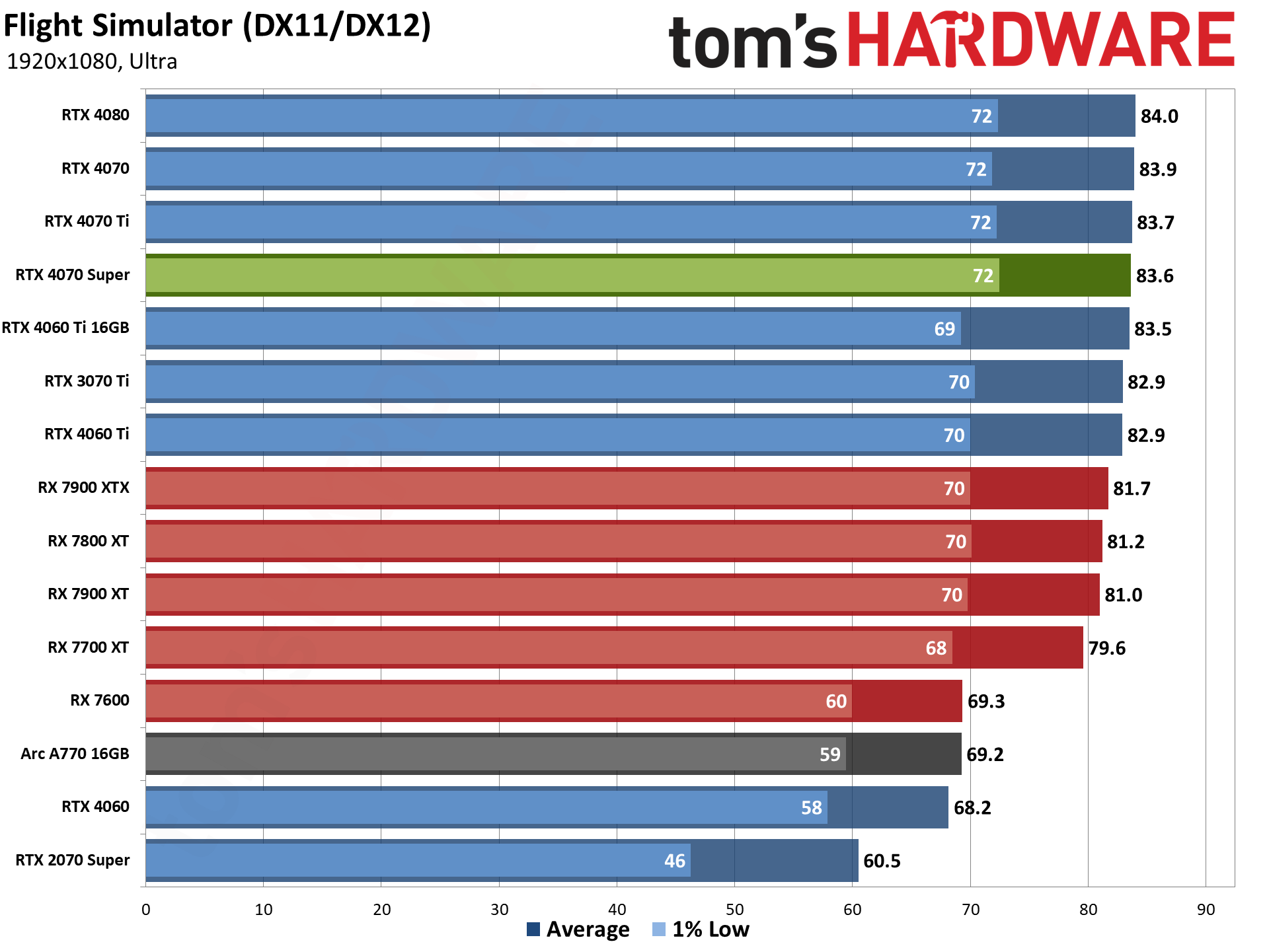
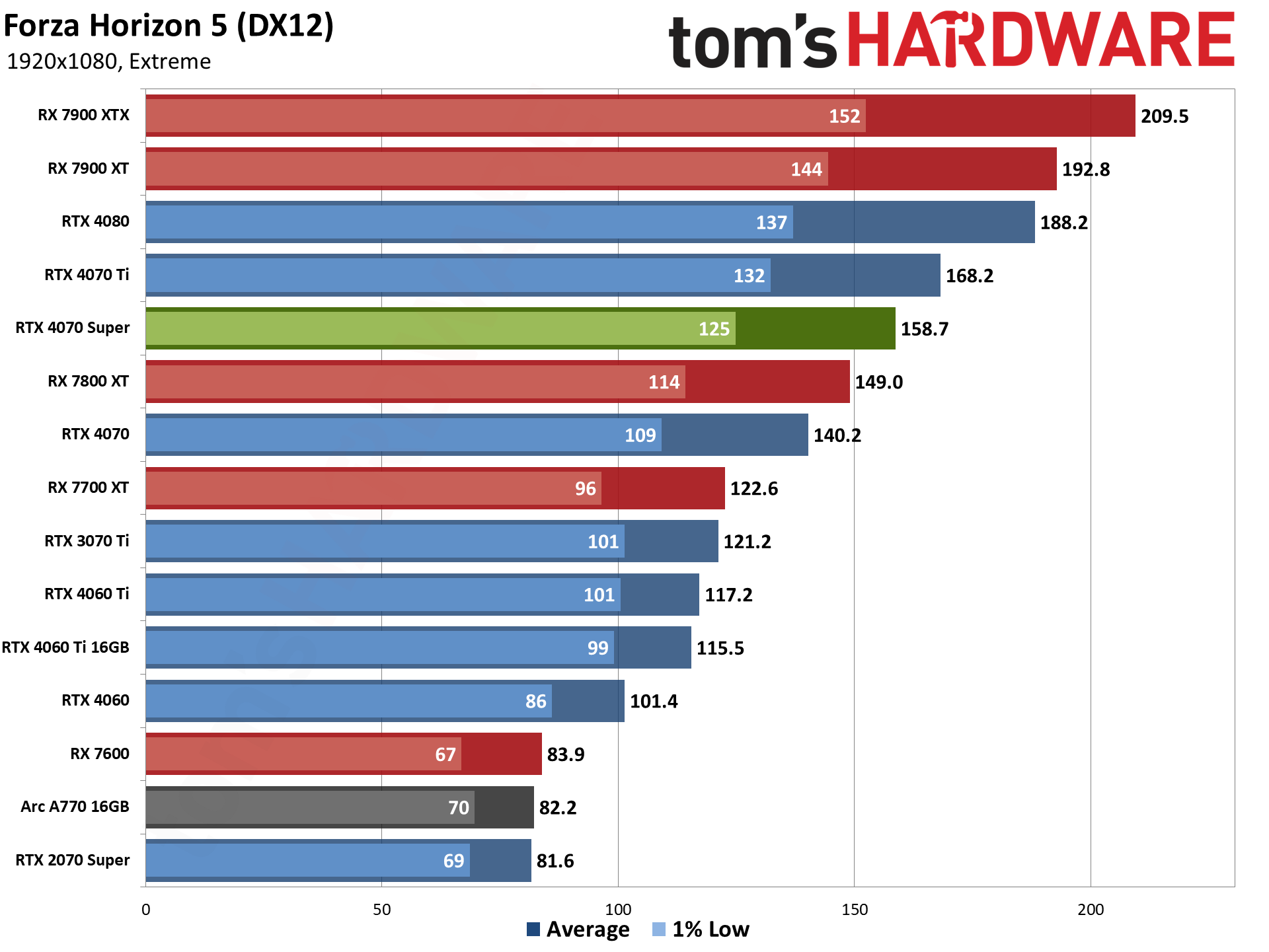
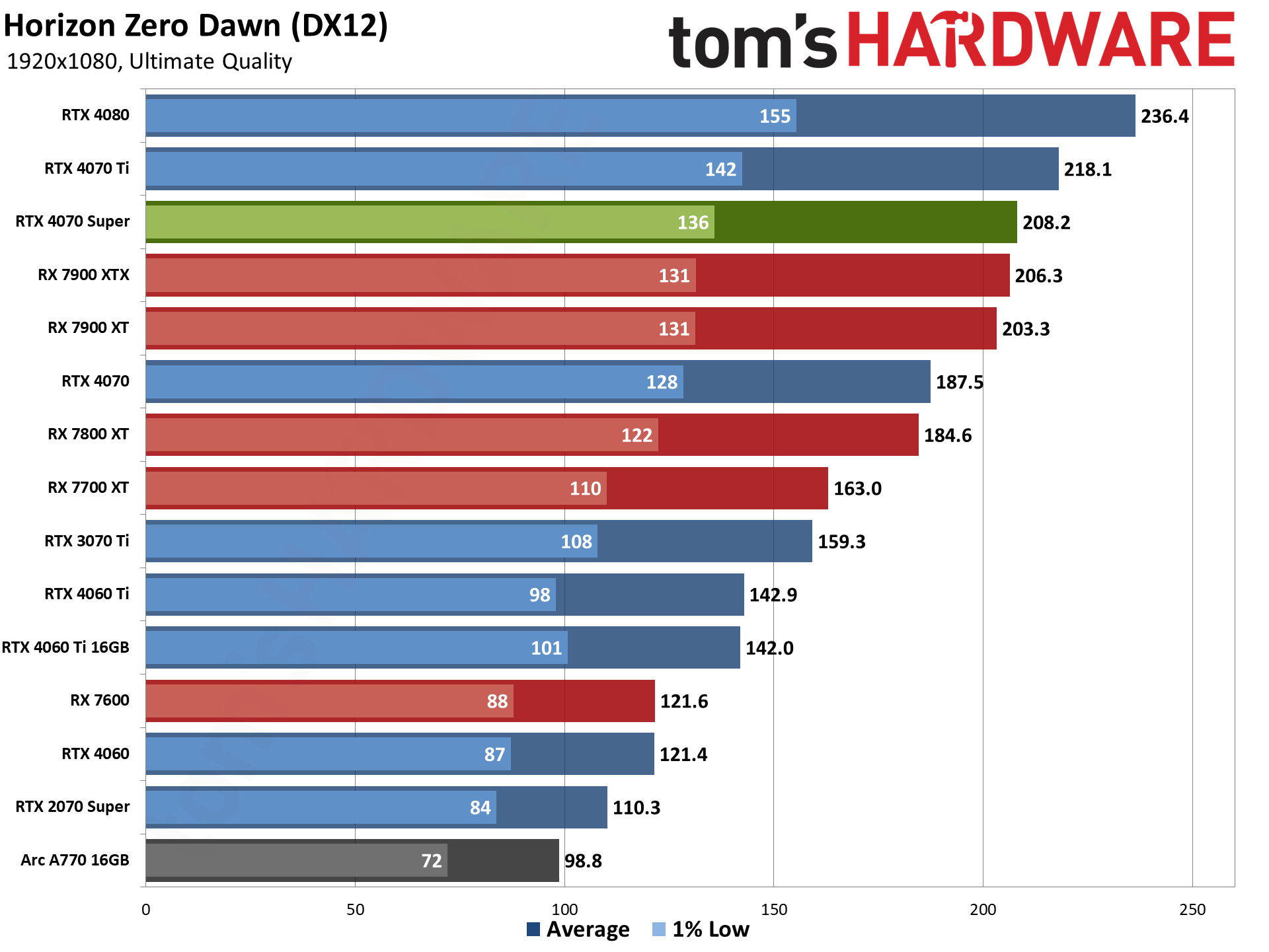
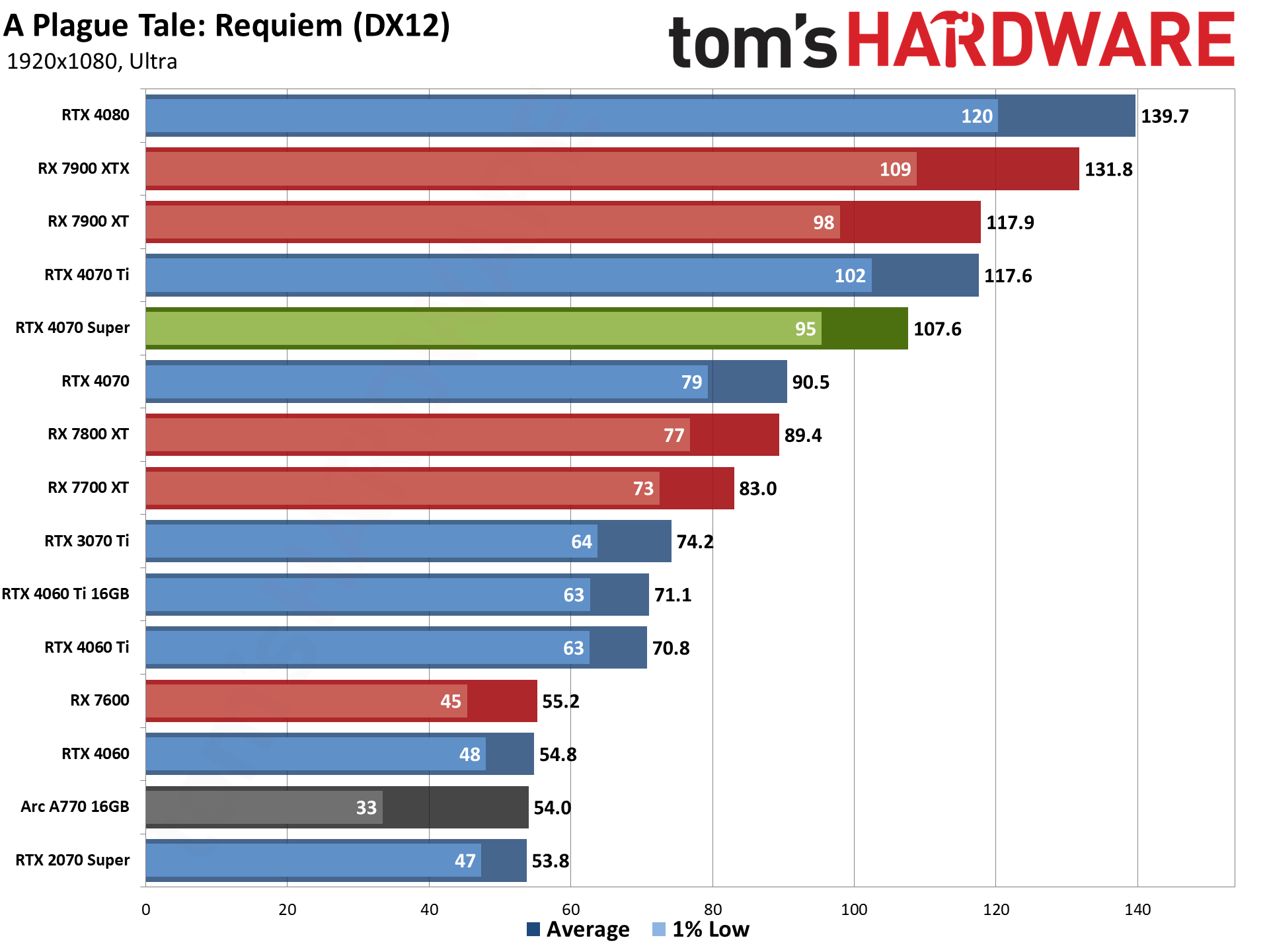
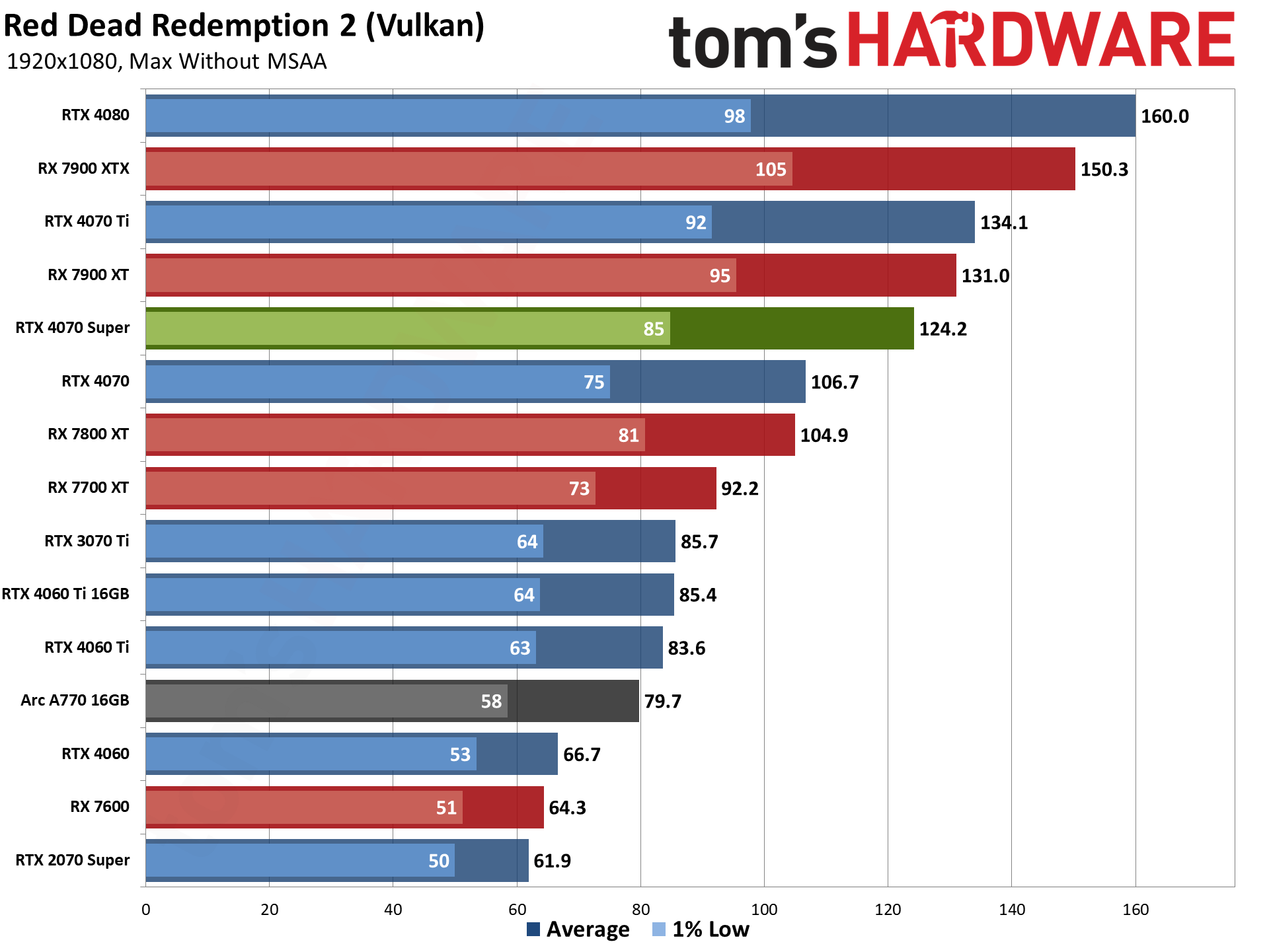





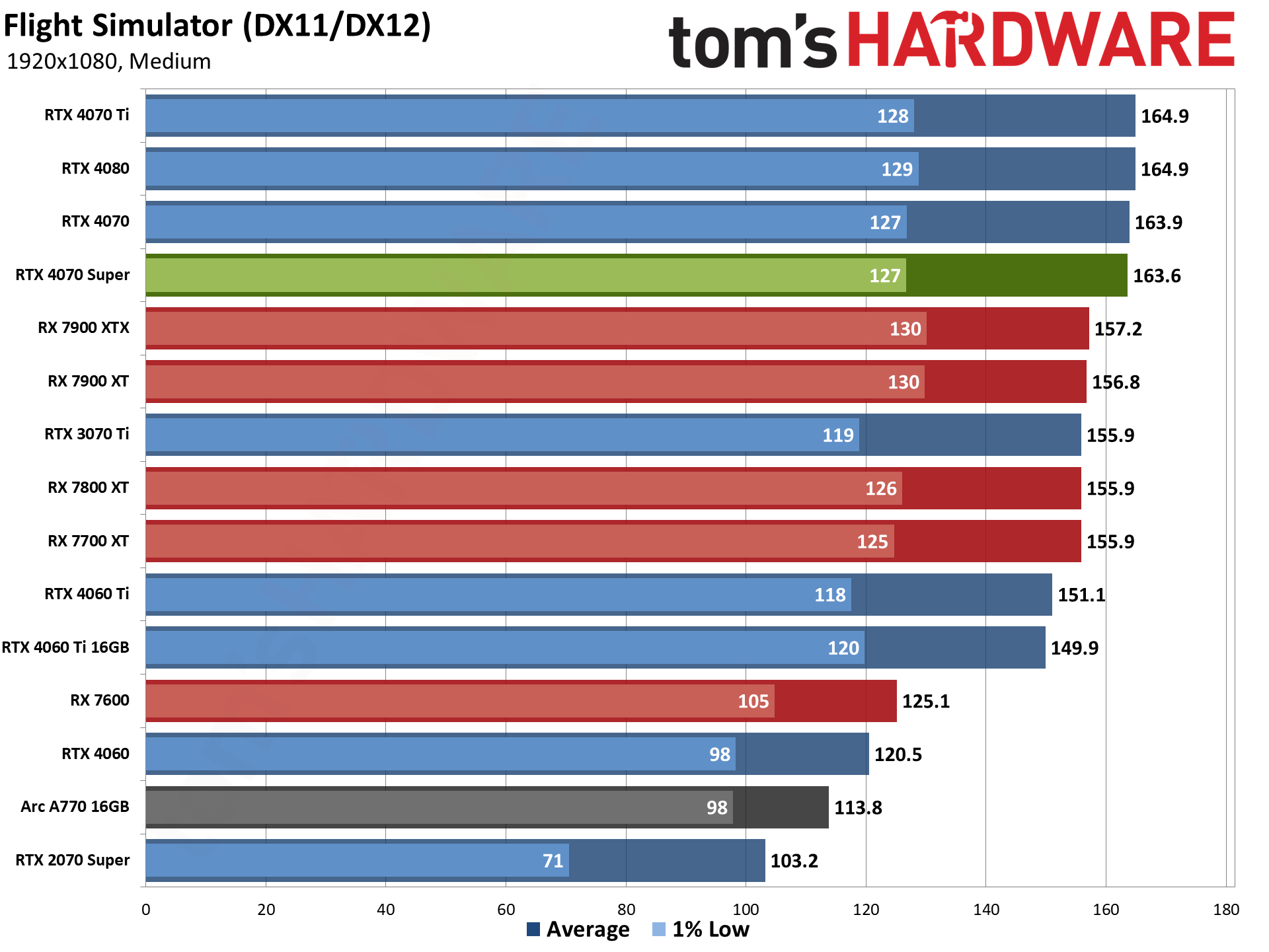
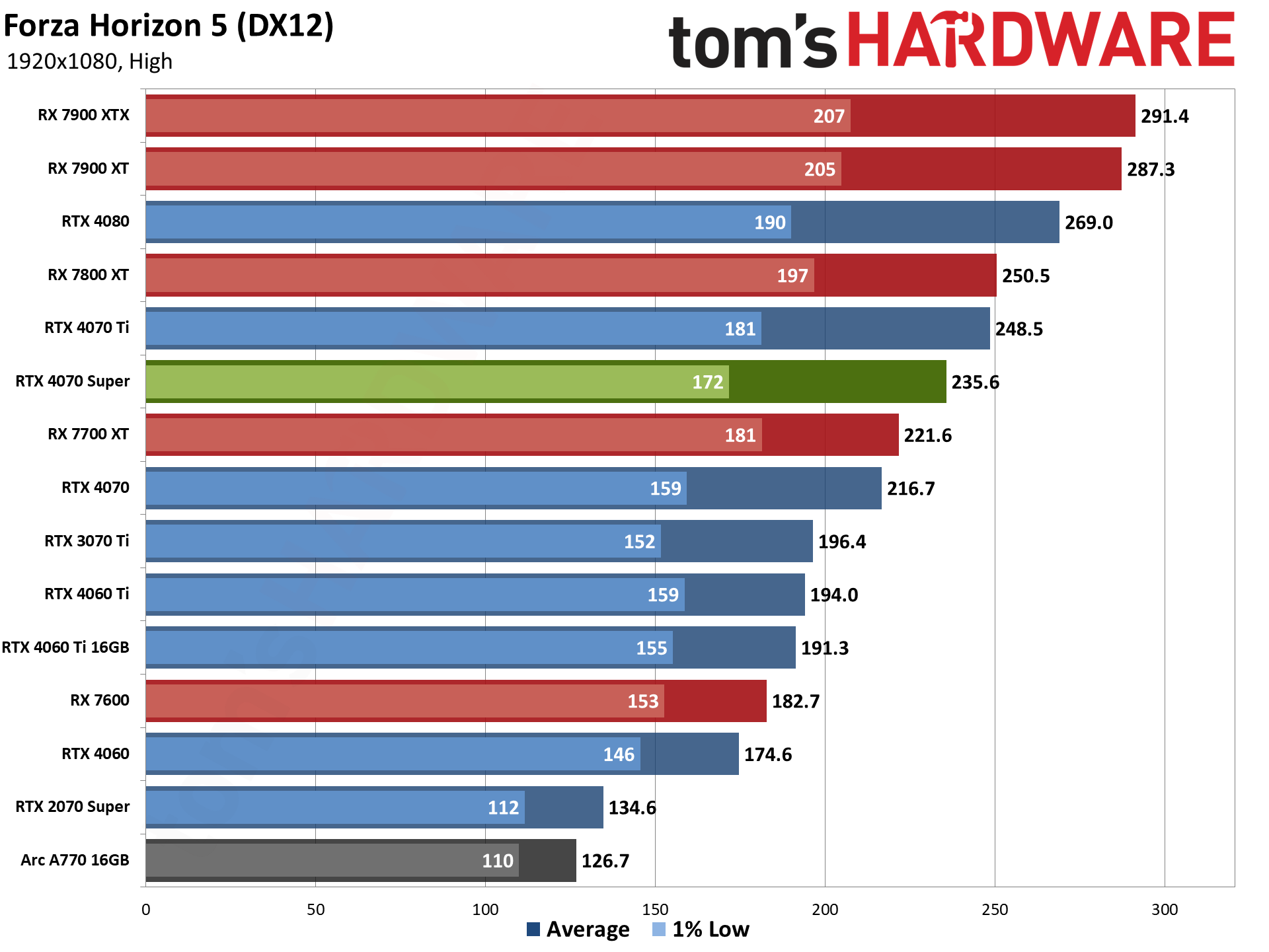
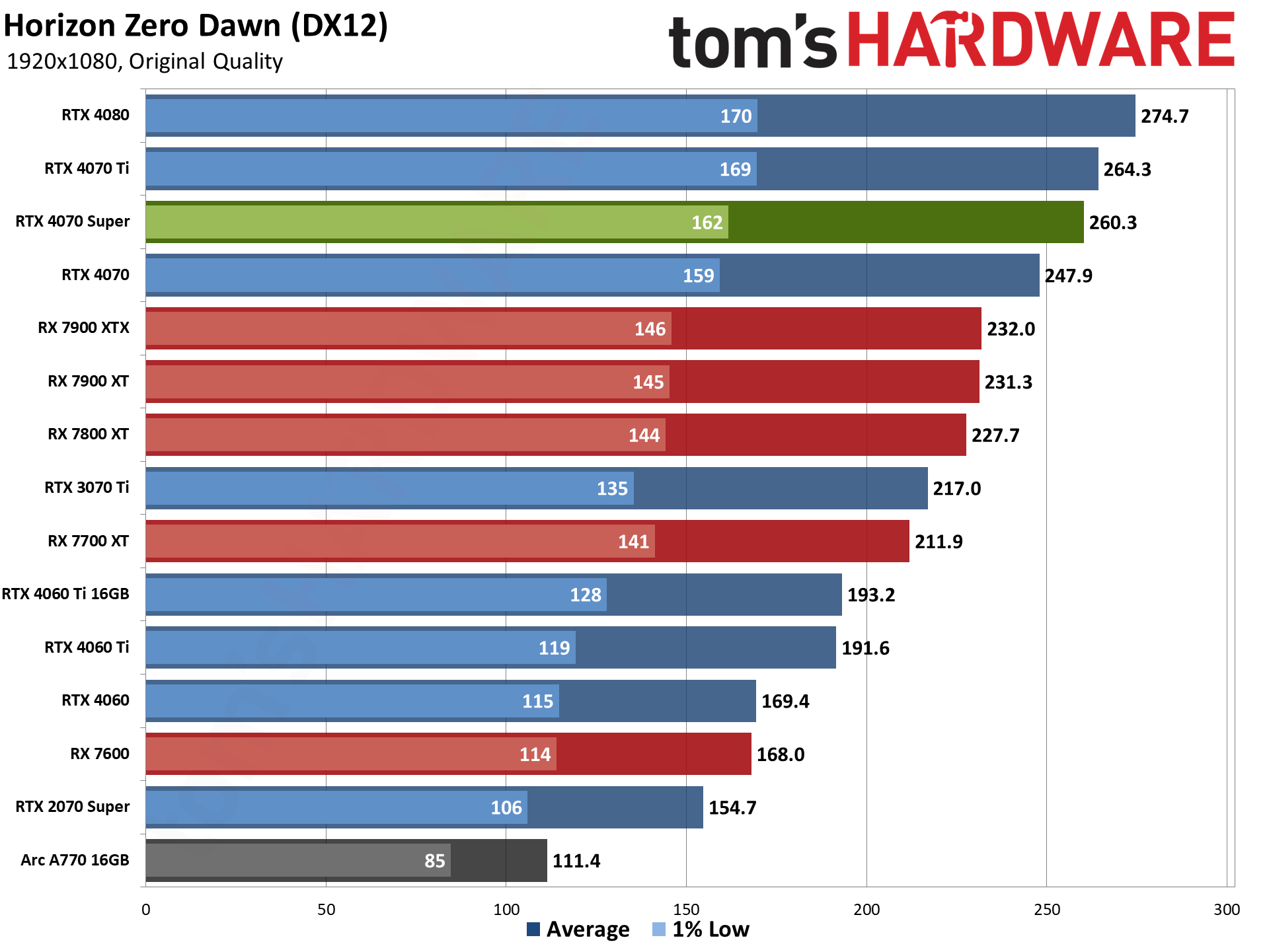
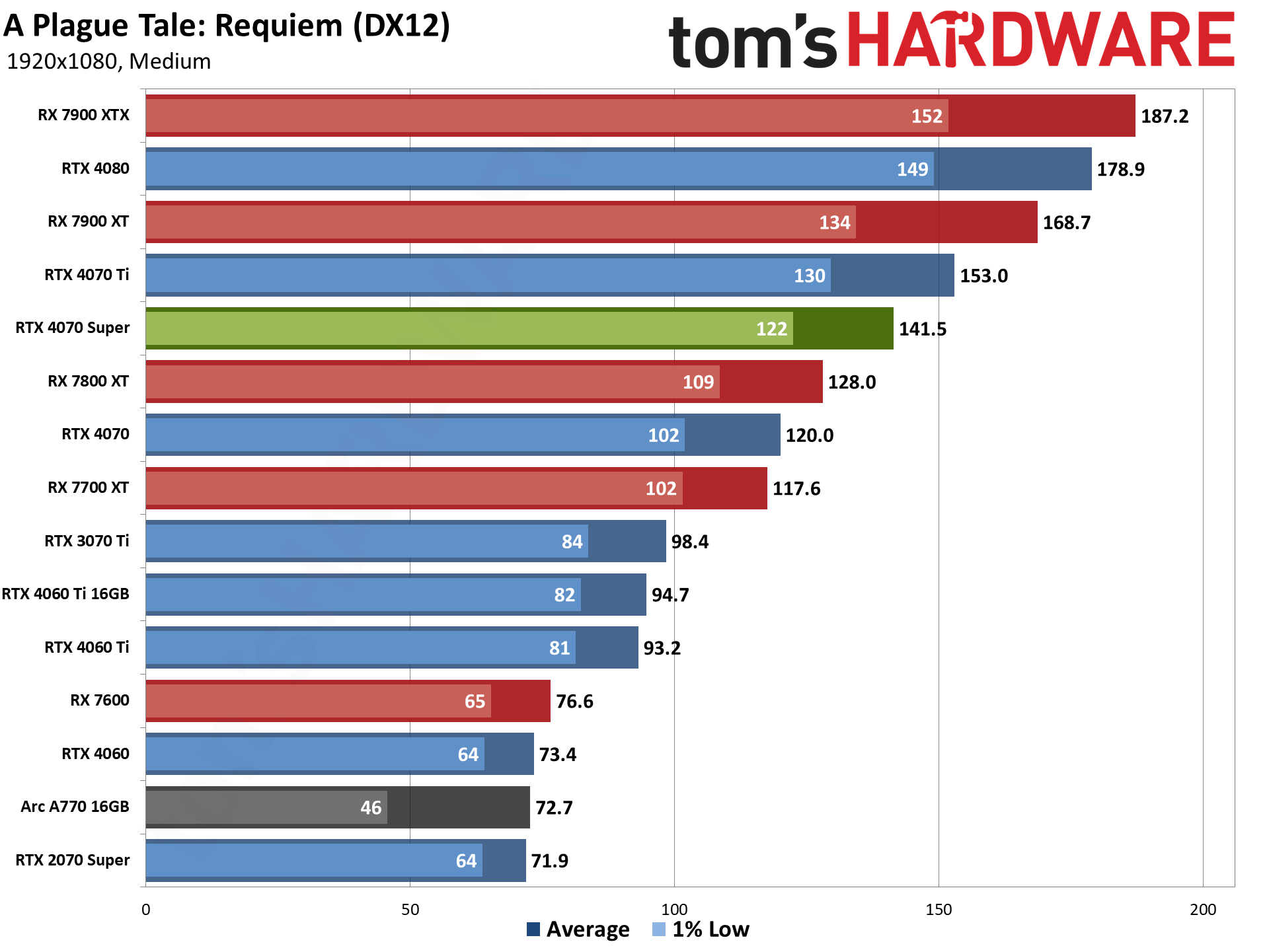
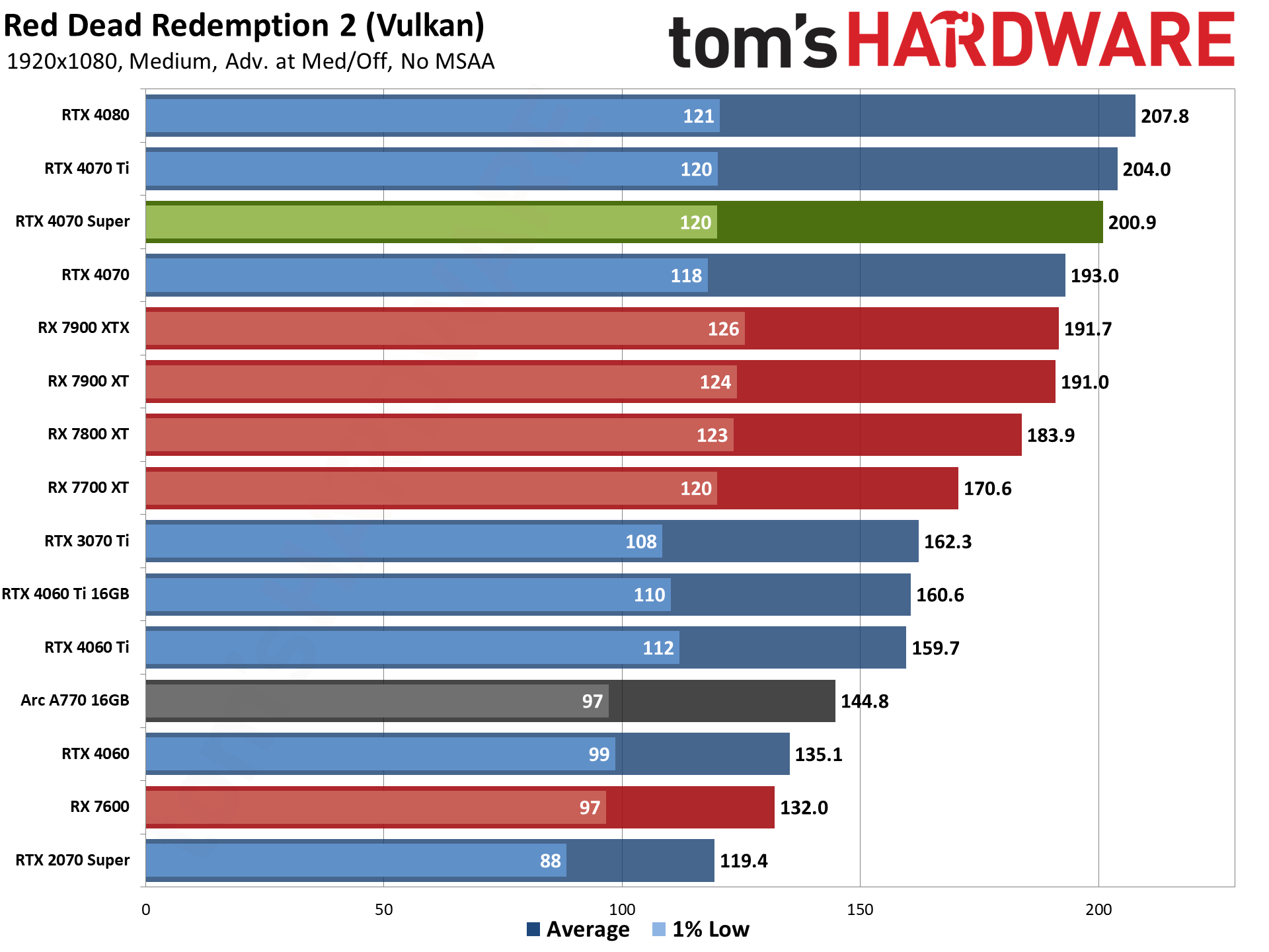
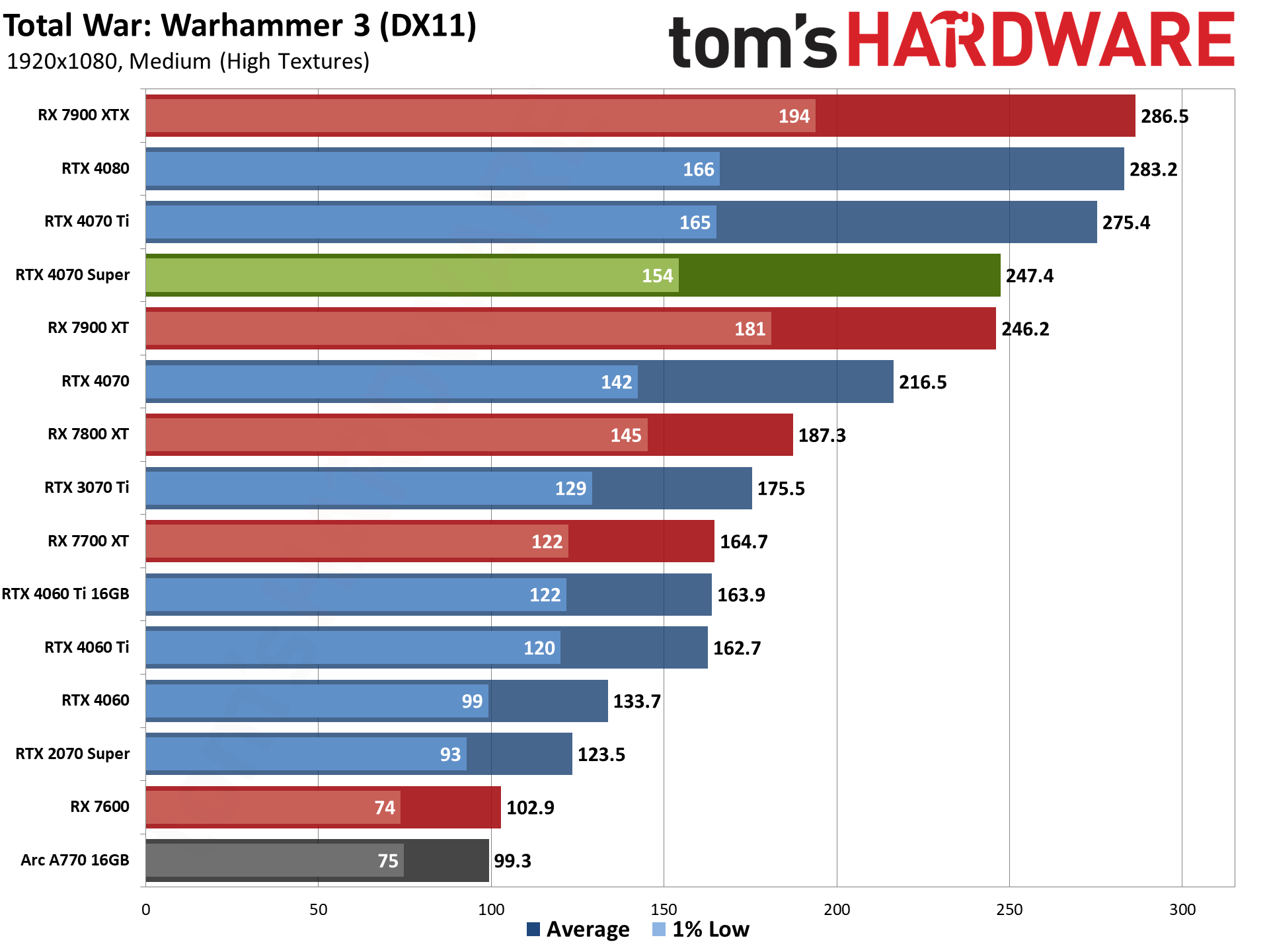

The full set of 1080p rasterization tests shows the usual mix of results, with overall 4070 Super performance basically tied with the 7900 XT at 1080p medium, and 5% less performance than the 7900 XT at 1080p ultra — or if you prefer, Nvidia's new GPU outperforms the 7800 XT by 7% at 1080p medium and 10% at 1080p ultra.
The individual results range from about 6% slower to 30% faster than the 7800 XT, with Total War: Warhammer 3 and A Plague Tale: Requiem being the two widest margins of victory. And compared to the vanilla 4070, you're getting 8% and 13% higher performance at medium and ultra settings.
Of course, no one is likely to upgrade from a 4070 to a 4070 Super. This is intended as a replacement for cards that are at least one generation old — and more likely two or more. If you have something like the 2070 Super, the 4070 Super delivers 73% more performance overall at medium settings, and 90% more performance at ultra settings — everything is a bit closer at 1080p than it was at 1440p ultra.
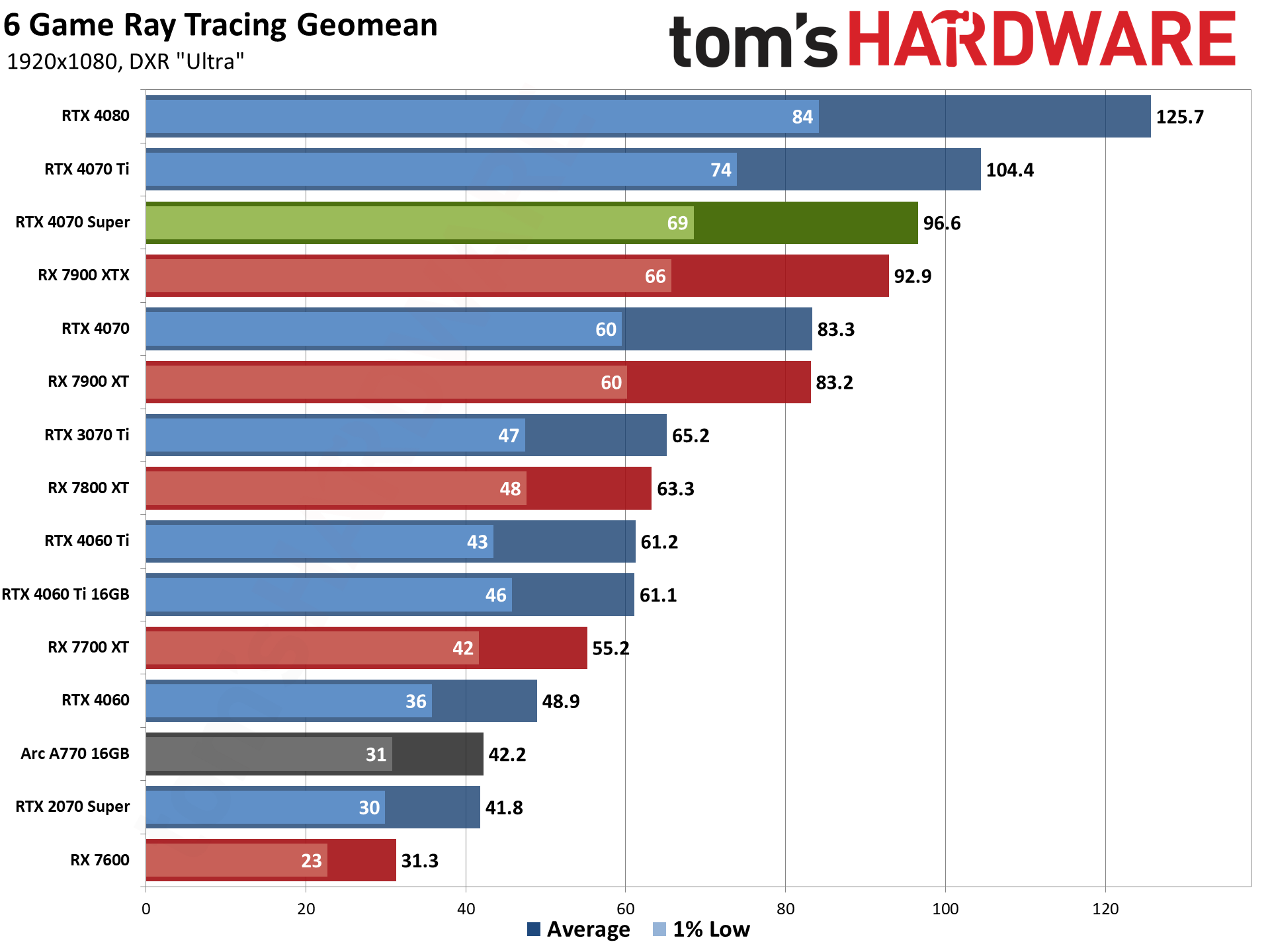

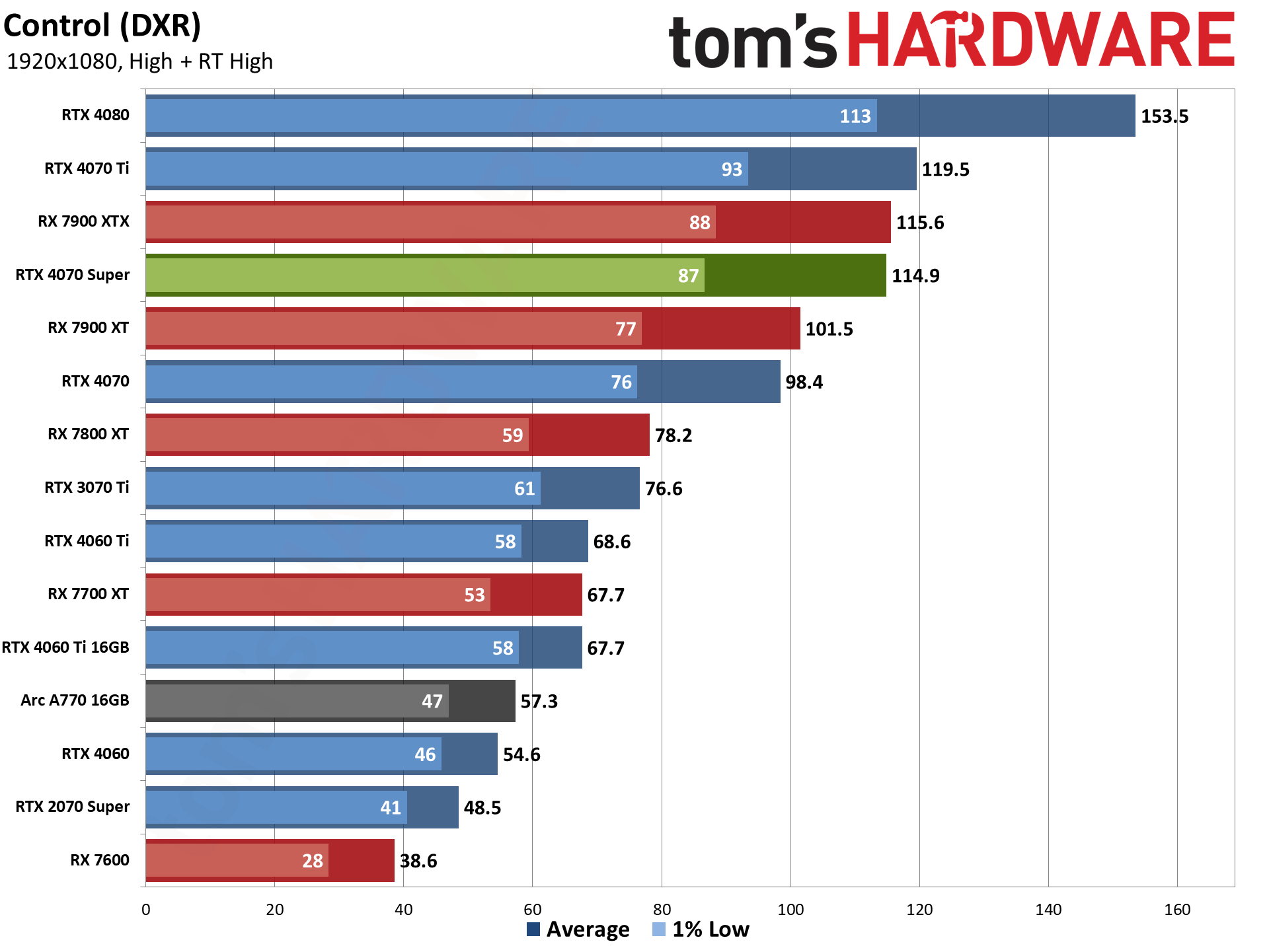

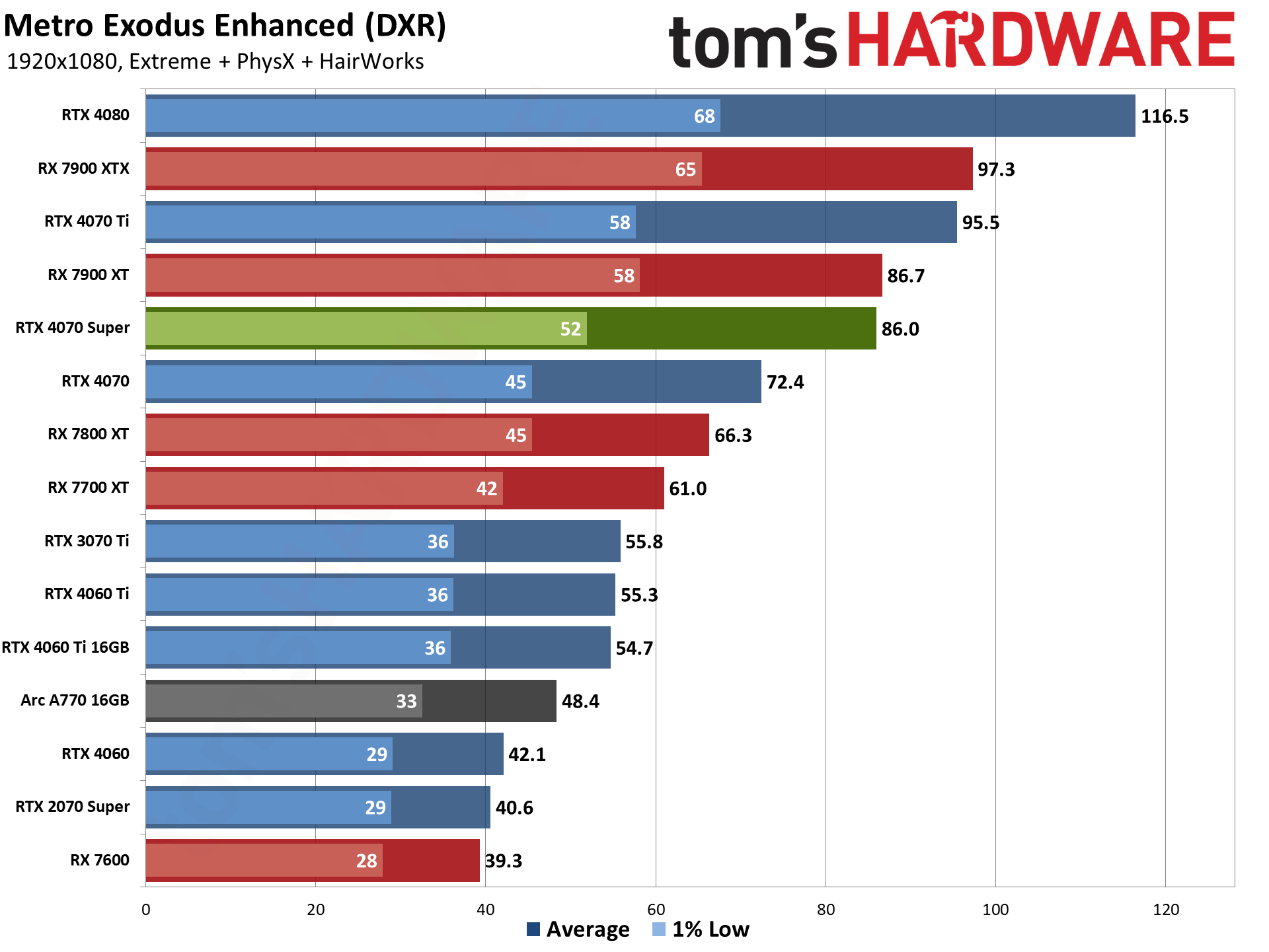

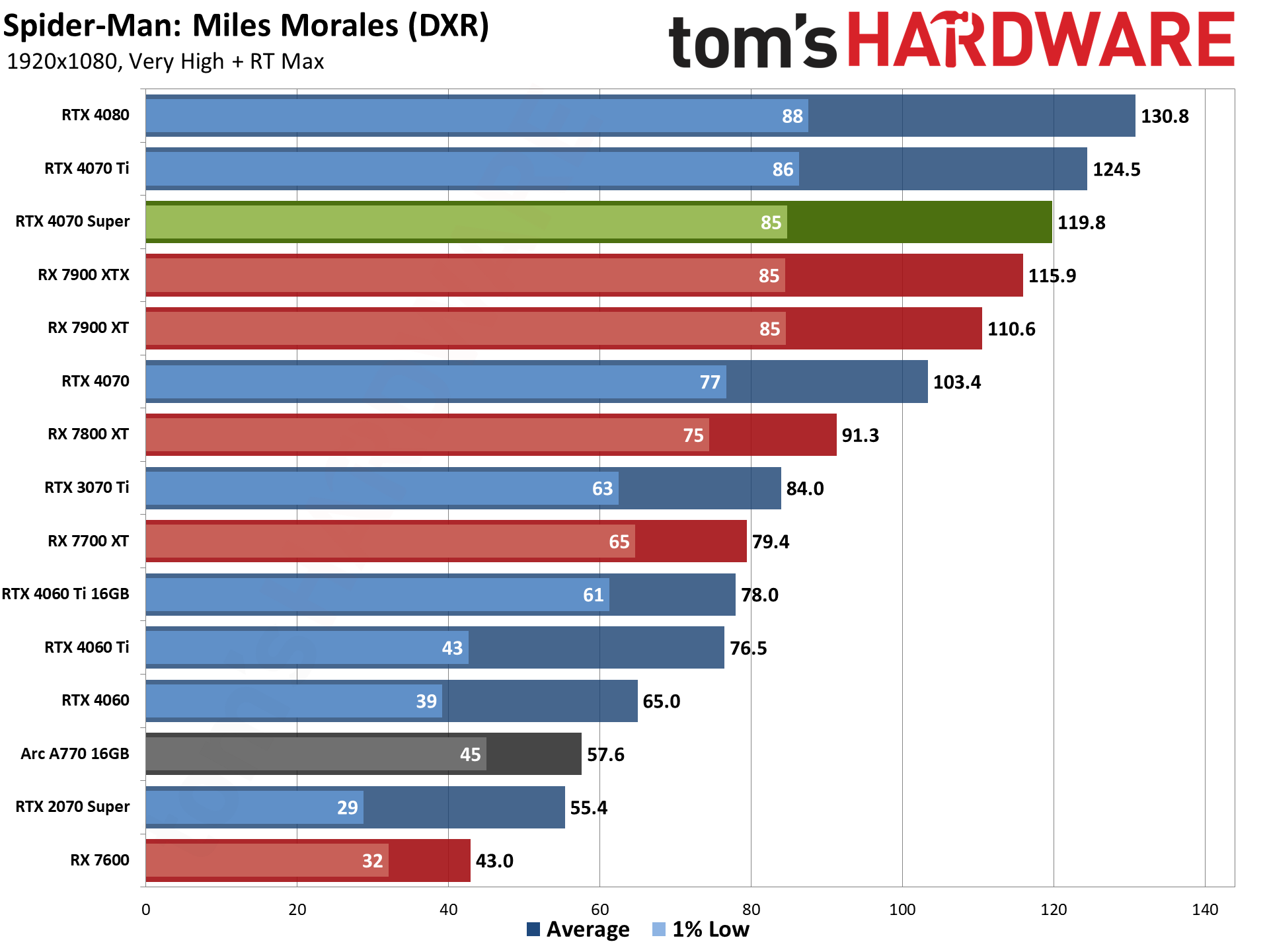
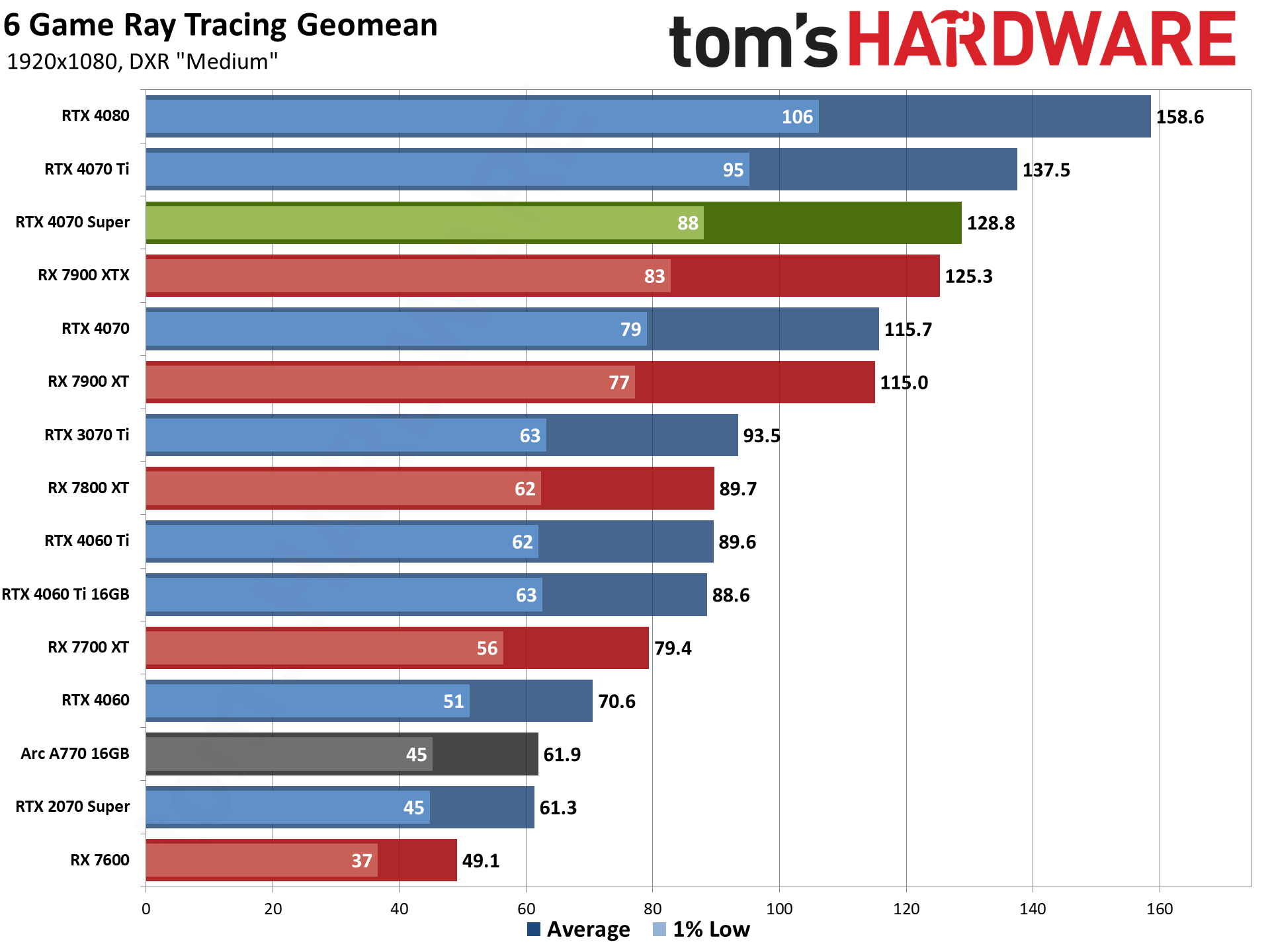
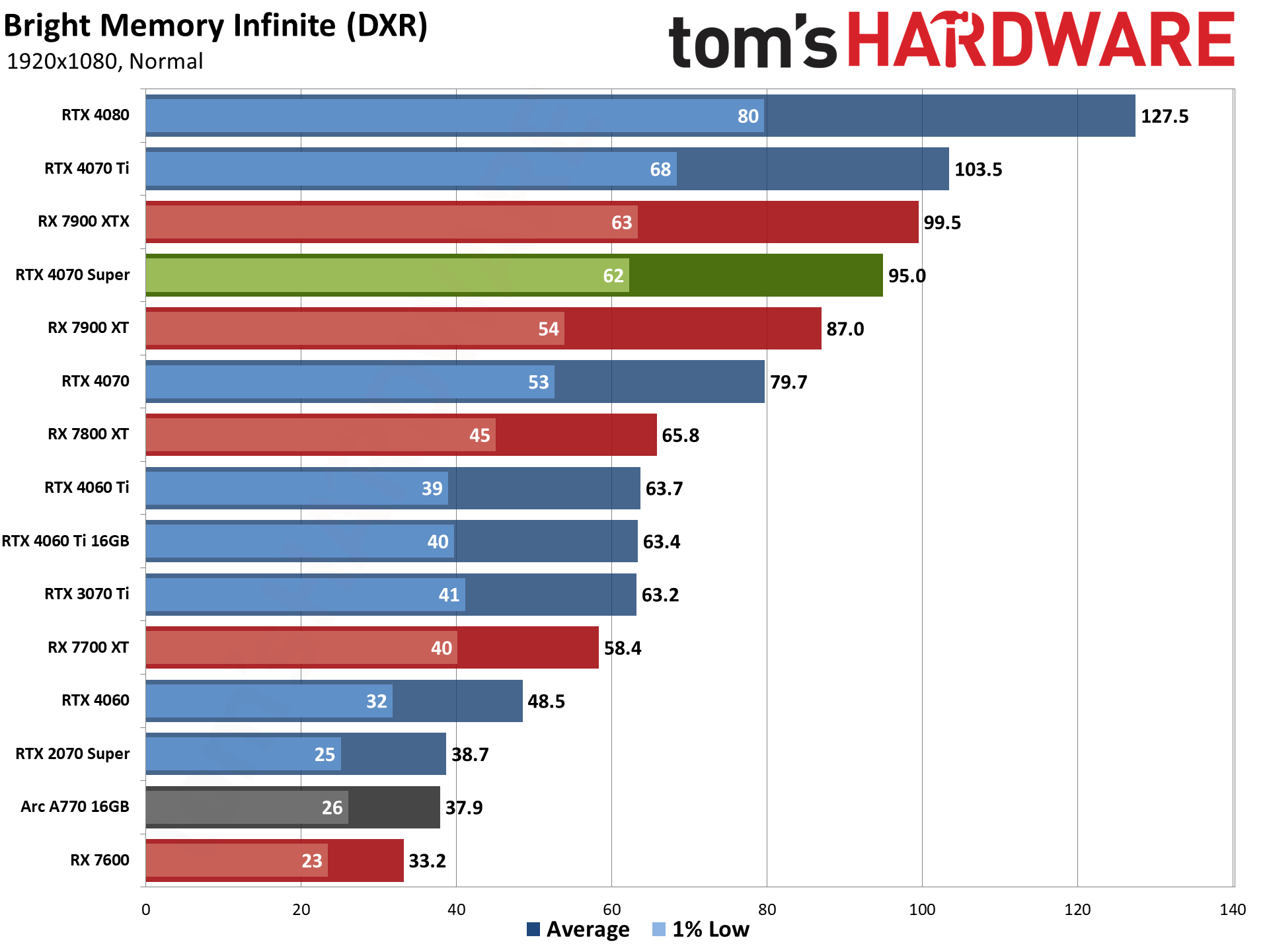
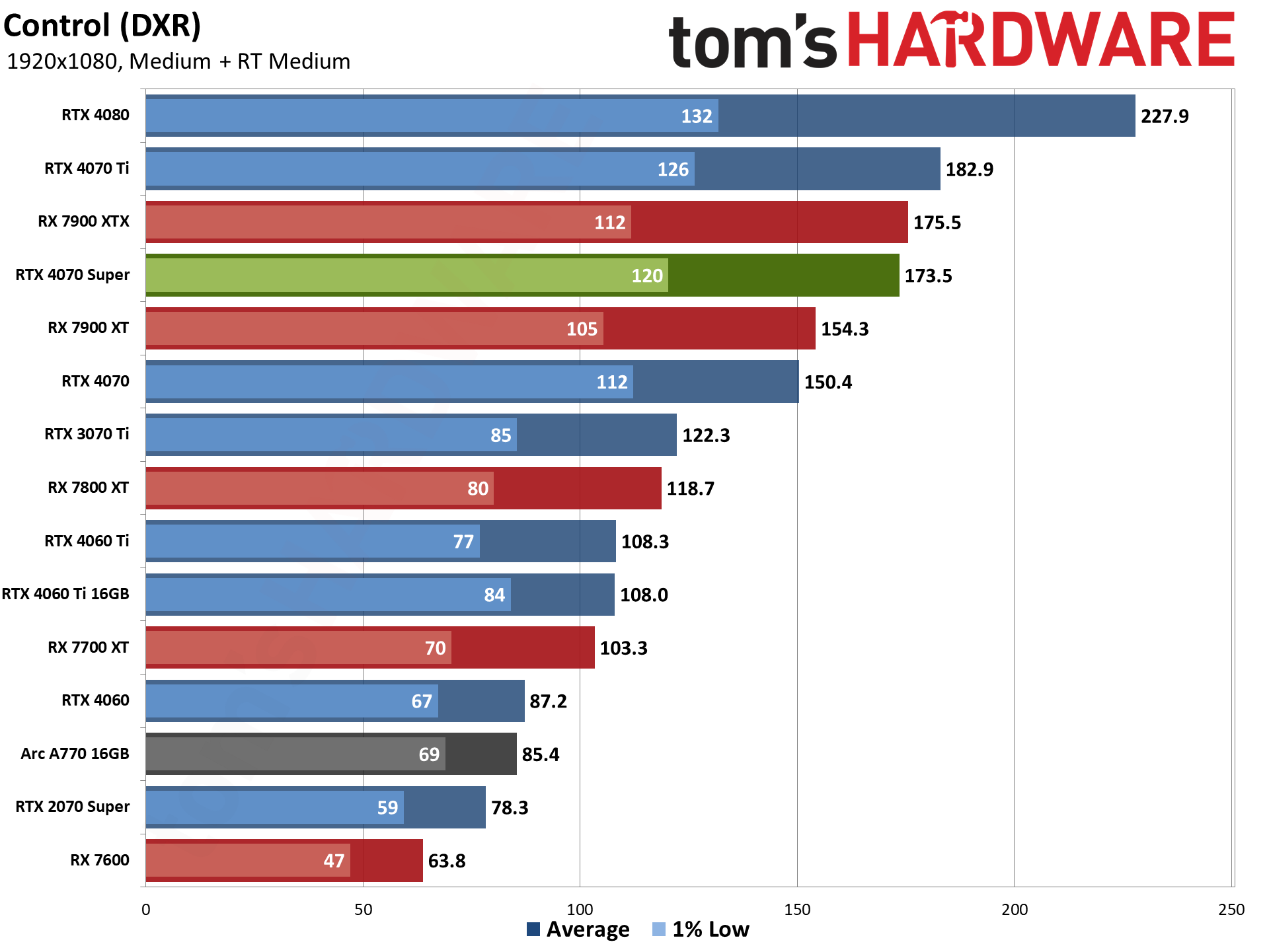


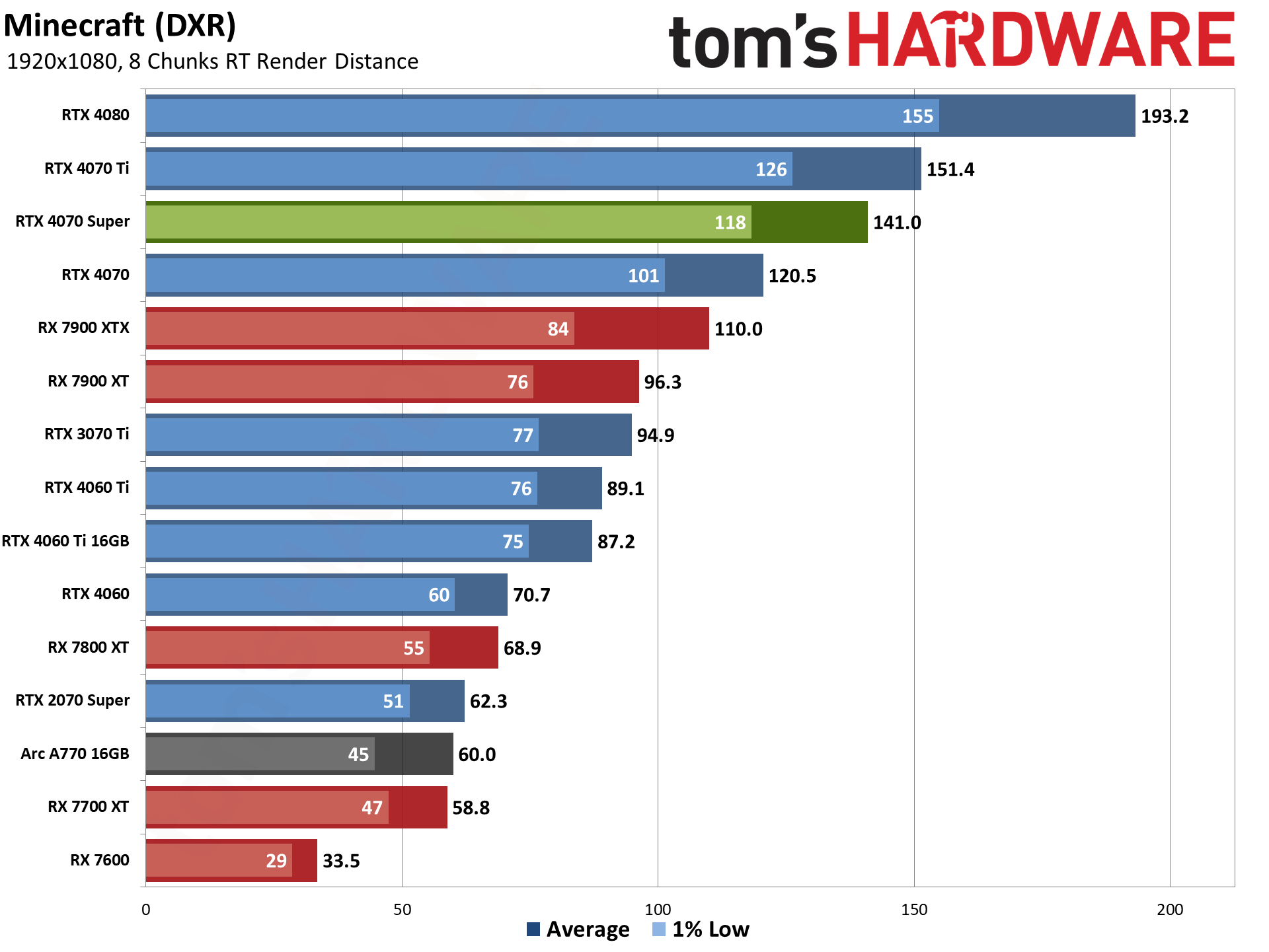
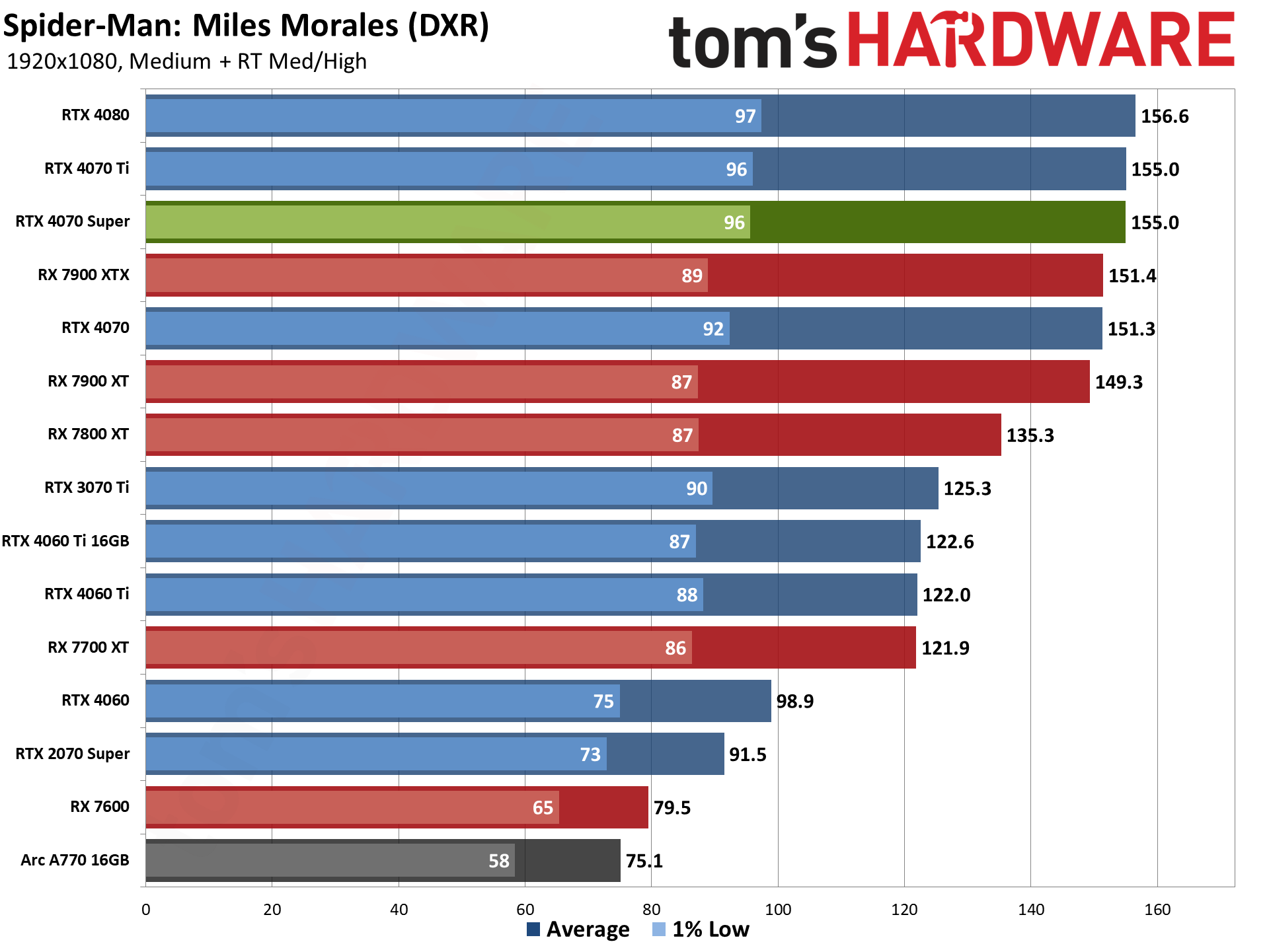
Ray tracing at native resolution can be a bit much at 1440p, but at 1080p every game still breaks the 60 fps mark, even at ultra settings. There are games where that won't be the case (such as Alan Wake 2, which we'll get to in a bit), but those should be the exception rather than the rule for the next couple of years.
Ray tracing as usual lets Nvidia's architecture strut its stuff, and overall performance from the 4070 Super edges past the RX 7900 XTX. Mostly that's because of Minecraft, where it has a 28–37 percent lead, and several of the DXR games still run faster on AMD's top card — thanks no doubt to the 24GB of VRAM and higher power limit.
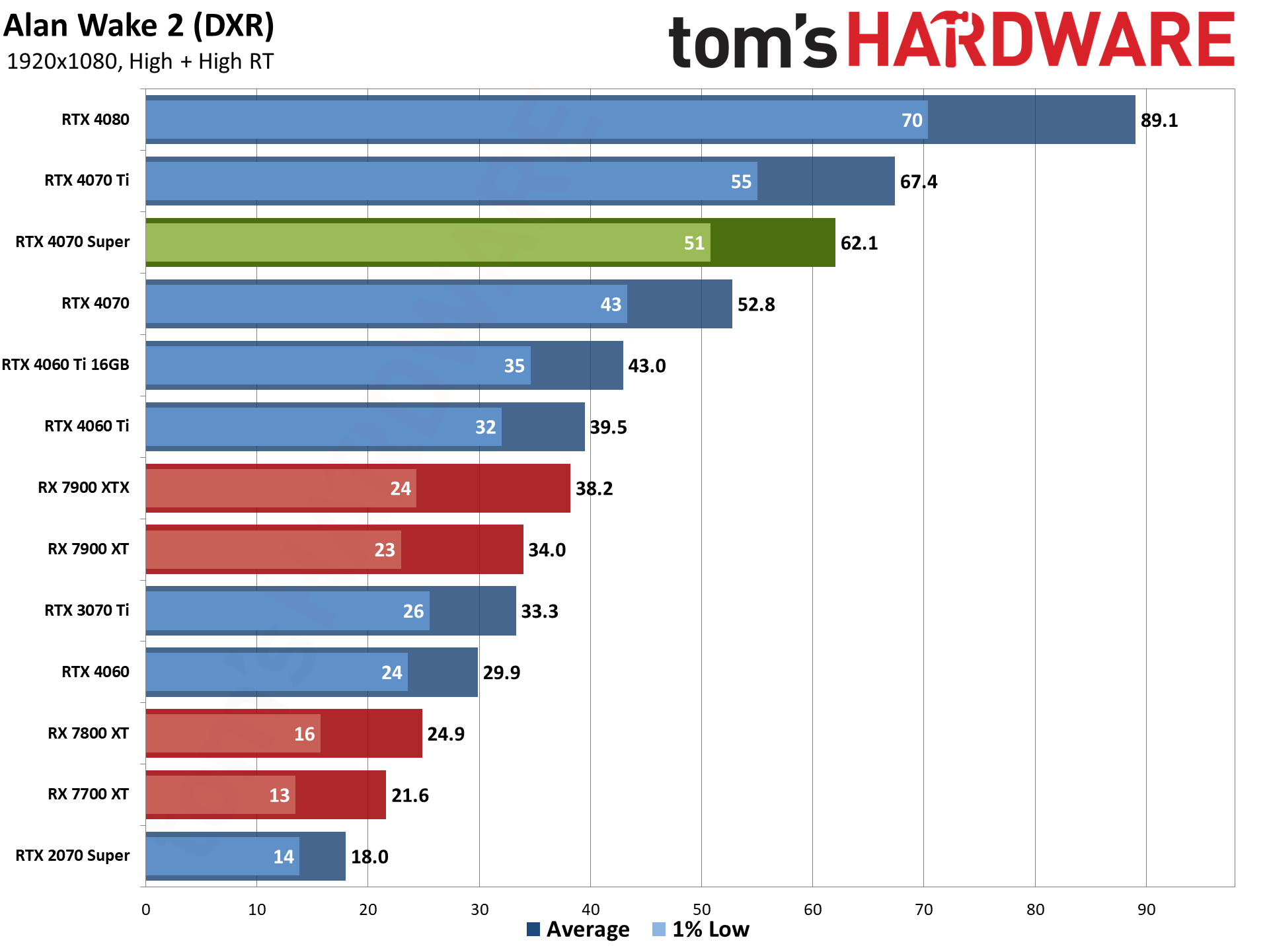

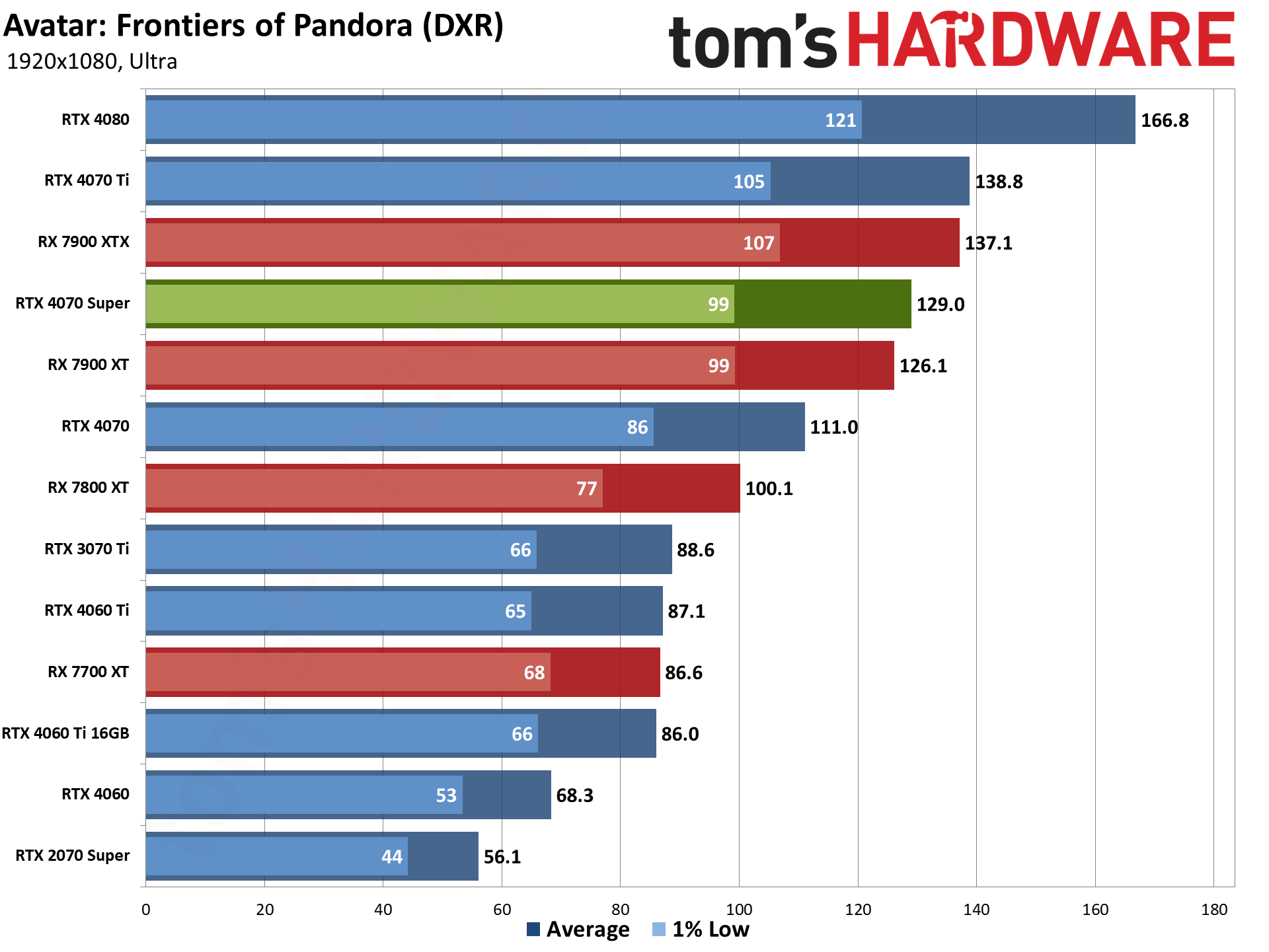
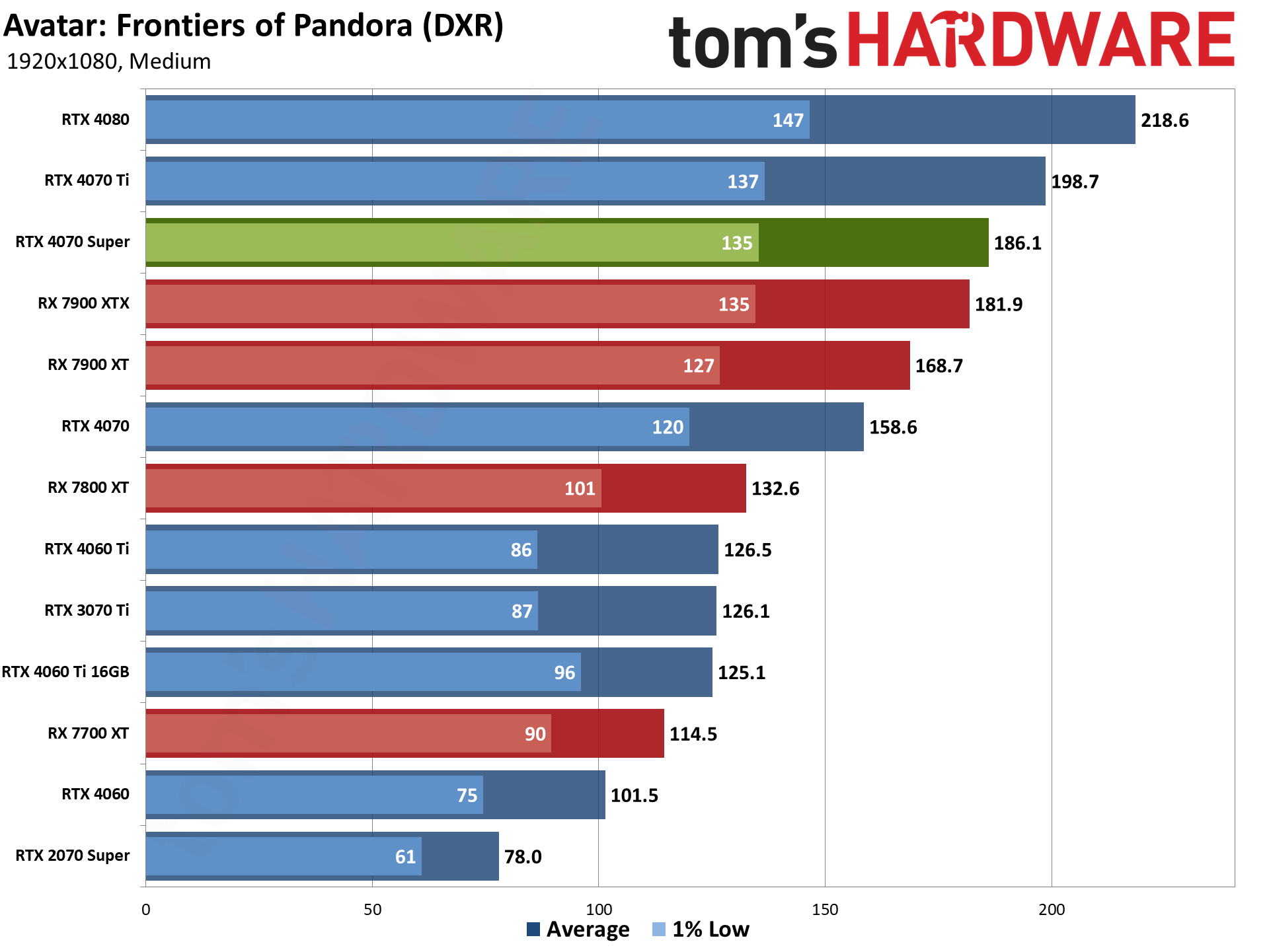

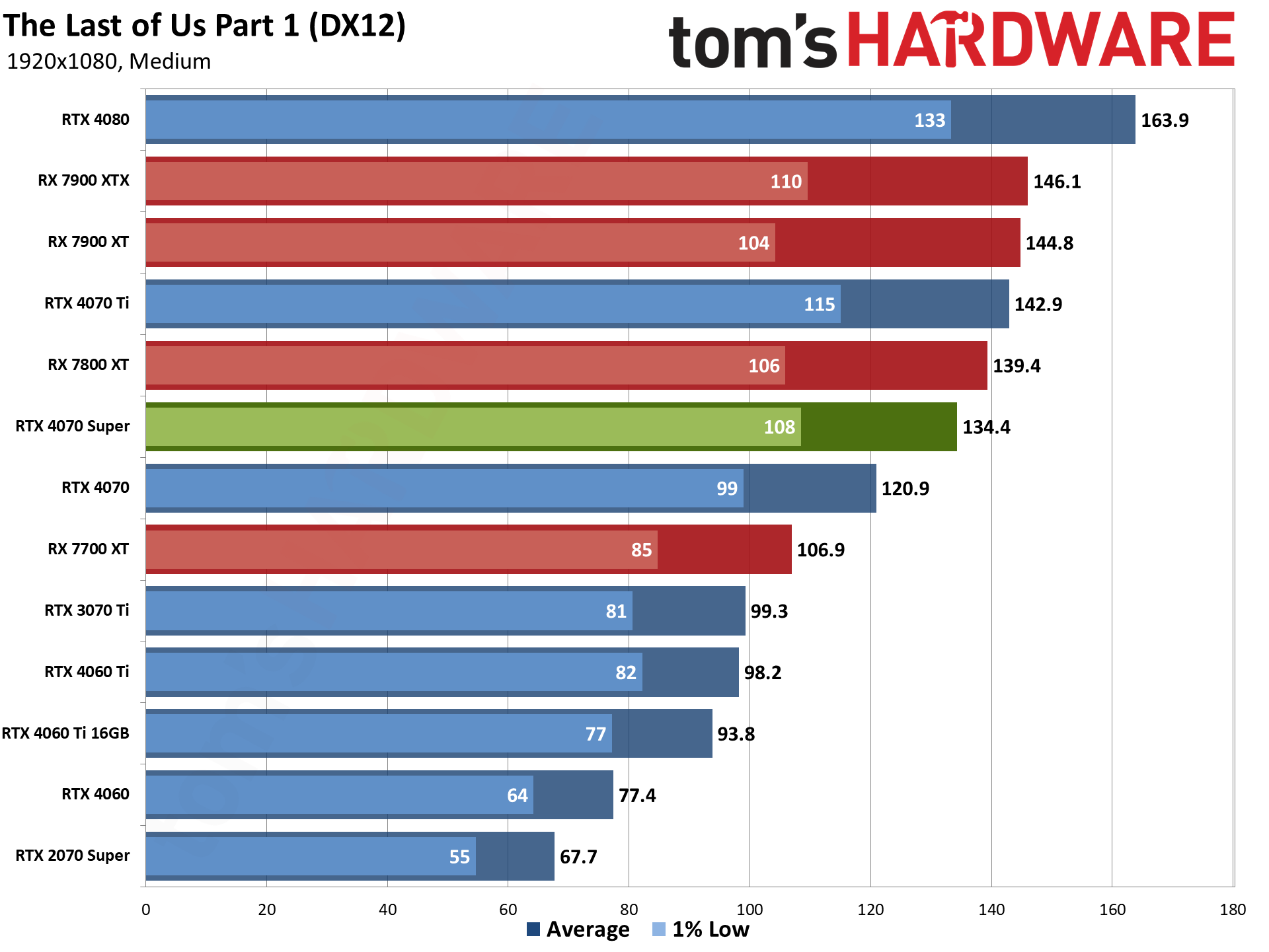
How about our three bonus games? Given how demanding Alan Wake 2 can bet at high settings (i.e. path tracing), it's impressive that it can even break 60 fps. AMD's GPUs are well off that mark, with even the 4060 Ti coming out ahead of the 7900 XTX. Medium with low RT settings isn't nearly so harsh, with the 4070 Super managing 82 fps.
The other two games are also much easier to run. Avatar gets 129 fps (with upscaling) at 1080p Ultra settings, landing between the 7900 XT and XTX. That's because Avatar uses ray tracing for shadows and reflections, or at least that's our most likely explanation.
The Last of Us again favors AMD's GPUs more than many of the other games we tested, with the 4070 Super coming in just behind the RX 7800 XT. We haven't tested these games on a few of the GPUs, so we're limited to 13 of the cards for these charts.
- MORE: Best Graphics Cards
- MORE: GPU Benchmarks and Hierarchy
- MORE: All Graphics Content
Get Tom's Hardware's best news and in-depth reviews, straight to your inbox.
Current page: Nvidia RTX 4070 Super: 1080p Gaming Performance
Prev Page Nvidia RTX 4070 Super: 1440p Gaming Performance Next Page Nvidia RTX 4070 Super: 4K Gaming Performance
Jarred Walton is a senior editor at Tom's Hardware focusing on everything GPU. He has been working as a tech journalist since 2004, writing for AnandTech, Maximum PC, and PC Gamer. From the first S3 Virge '3D decelerators' to today's GPUs, Jarred keeps up with all the latest graphics trends and is the one to ask about game performance.
-
Gururu So they squeeze out a few more FPS to beat the 7800xt and charge $50 more. The price games are maddening.Reply -
AgentBirdnest Mostly what I was expecting... but wow, those results against the 7800XT at 1440p are kinda crazy. +24% for the whole suite, and about +50% in the RT-only results? AMD really needs to rethink the price of the 7800XT.Reply
Interesting results, and interesting article (so far. I look forward to the rest. Hope you get some good sleep until then, Jarred. :))
I'm curious to know how well it overclocks. Can it match the 4070 Ti? -
atomicWAR While a step in the right direction, the ram capacity is still really underwhelming but the performance is promising. The 4070 series (Ti, super or otherwise) should have come with 16GB while the 4080 series should have had 20GB...This gen, save the 4090, has been really disappointing. Cost increases (70/80 series) with underwhelming performance (60/70/80) have been fairly pervasive in the product stack. I hope this helps things...I am interested in the 4070 Ti Super as many of my nephews and nieces have been wanting to upgrade this gen and thus far it has been hard to recommend anything other than the 4090 to them which is out of their budgets by about 700 dollars give or take a hundred.Reply -
Tom Sunday Reply
12GB of 4070 SUPER bliss? That is the million dollar question? At this point in time I would expect more than 12GB of VRAM in especially 2024. Even a 1080ti already had 11GB of VRAM in its side pocket. Will it pay in holding-out for a 4070 Ti SUPER: 2.5X Faster than the RTX 3070 Ti and sporting a mouth watering 16GB of GDDR6X? With that along bolstering CUDA cores, VRAM and reaching 4K gaming heaven? Will in fact a 4070 Ti SUPER be essentially a slight cutdown of the original RTX 4080, meaning that one can expect to see similar performance from the two cards?Gururu said:So they squeeze out a few more FPS to beat the 7800xt and charge $50 more. The price games are maddening.
Overall and in my very limited view the ‘4070 Super Refresh’ series is indeed a welcomed addition. It's commendable that the Super’s overall offer much better ray tracing performance, better energy efficiency and generally a notable performance upgrade compared to the Non-Super cards. No question that NVIDIAs latest 'Super-Play' will certainly put AMD under greater pressure, because they offer more performance and efficiency for basically the same price points. On the flipside I understand that the 4070 Super Refreshes do give the impression that they are only a mid-cycle gap filler. Because of the price? Further if AMD would only lower the price of the 7800XT, many I think would still go for the XT. In some instances AMD reputably has long preferred to stake a few cards at higher prices than to gain market share through price reductions. Food for thought! -
pocketdrummer Toms Hardware needs to do a price to generation performance uplift chart. Use performance uplift as the tier and not the actual product names (xx70 and xx80 mean nothing now). I'm sure we'll see that the price has gone up and the performance uplift has not tracked.Reply -
kyzarvs Call me a luddite as I remain on a venerable 1080ti, but I'm not sure I would trust laying down £600 for a 12GB card today and hoping it works as well as far into the future as my current card has. While it may be okay today, when it's as old as my 1080ti is now, I think 12GB will be a massive limitation.Reply -
Alvar "Miles" Udell At this point I'd have to tell people that unless they have a pre-RTX 2000 series card to wait for the 5000 series. Yes the 4070 Super is a solid 4K60 and 1080p144 (and a case by case basis 2560x1440 120fps) card, but you're still dealing with 12GB VRAM and a very unnecessary 16 pin power adapter for $600+ in an era of horrible economics.Reply -
logainofhades ReplyAgentBirdnest said:Mostly what I was expecting... but wow, those results against the 7800XT at 1440p are kinda crazy. +24% for the whole suite, and about +50% in the RT-only results? AMD really needs to rethink the price of the 7800XT.
Interesting results, and interesting article (so far. I look forward to the rest. Hope you get some good sleep until then, Jarred. :))
I'm curious to know how well it overclocks. Can it match the 4070 Ti?
That 24% is only due to RT. If you look at pure raster performance, the gap is much smaller. Definitely not worth the $90 ish price premium, unless you truly care about RT, which I personally do not.
-
subspruce Reply
No, ofc not. Nvidia pushes their chips to the max that they can without having more not-up-to-requirements GPUs than can be offloaded as some kind of China Quadro.AgentBirdnest said:I'm curious to know how well it overclocks. Can it match the 4070 Ti? -
oofdragon Only in Toms Hardware fairy tale land the 4070 matches the 7800xt in raster, everywhere else the 4070Ti ties with it. This website is a jokeReply
